Kitchen Hygiene: Clean for Safety and Prevent Foodborne Illness

Have you thought about how much you need to clean your kitchen to prevent foodborne illness? Each year, 1 in 6 Americans fall ill from eating bad food. Knowing how to keep your kitchen clean is vital to stop this.
Keeping your kitchen clean affects your food’s taste and safety. It keeps bad germs away. These germs can make you sick if they spread in your kitchen. So, cleaning your kitchen well stops you and your family from getting sick.
Next, let’s learn more about food safety. It helps keep your kitchen safe and healthy.
Understanding Food Safety
Food safety keeps us healthy by avoiding foodborne illnesses. Every year, about 48 million people in the U.S. get sick from bad food. So, knowing how to handle food safely is key to staying healthy.
What Is Food Safety?
Food safety means keeping food clean and safe to eat. It includes keeping food at safe temperatures, avoiding the mix of different foods, and washing hands well. It’s all about stopping bad germs from making us sick.
Why Food Safety Matters
Foodborne illnesses can make people very sick, or even cause death. Each year, foodborne illnesses lead to 128,000 hospital stays and 3,000 deaths in the U.S. Food safety is extra important for people who are at greater risk, like pregnant women, kids, older adults, and those with weak immune systems.
Making sure food is safe helps everyone. It saves money on doctor’s bills and keeps people from missing work. In countries that don’t have a lot of money, foodborne diseases can cause a loss of about $95.2 billion a year.
Learning and following food safety rules helps keep our food supply safe. By learning more and helping others do the same, we can stop foodborne illnesses. This makes everyone’s life better.
Common Foodborne Illnesses
It’s very important to understand common foodborne illnesses. This keeps your kitchen safe. Different germs cause these illnesses, and they have their own signs. We will show you how to spot these germs, the signs they cause, and the foods they’re often in.
Symptoms of Foodborne Illnesses
Foodborne illness symptoms can be different, but most involve stomach problems. Some common signs are:
- Nausea
- Vomiting
- Diarrhea
- Abdominal cramps
- Fever
For example, Bacillus cereus can make you sick in 10-16 hours and lasts 1-2 days. But, Clostridium botulinum is much worse, it can stop your breathing and be deadly. It starts in 12-72 hours.
Most Common Pathogens
Many germs cause foodborne illnesses. Let’s look at some:
| Pathogen | Onset | Duration | Annual Cases in the U.S. |
|---|---|---|---|
| Noroviruses | 12-48 hours | 12-60 hours | 5.4 million cases |
| Salmonella | 6-48 hours | 4-7 days | 1.2 million cases |
| Campylobacter | 2-5 days | 2-10 days | 1.3 million cases |
| Clostridium perfringens | 8-16 hours | 24 hours | 1 million cases |
| E. coli | 1-3 days | 3-7 or more days | 176,000 cases |
High-Risk Foods
Some foods have a bigger risk of carrying germs. Knowing these can lower your risk of getting sick. For example:
- Poultry: Often has Campylobacter and Salmonella.
- Meats: May contain E. coli and Salmonella.
- Unpasteurized Dairy: Can have Listeria.
- Eggs: Salmonella is common in them.
- Prepared foods kept warm: They can grow Clostridium perfringens.
To wrap up, knowing the symptoms, the usual germs, and risky foods helps prevent foodborne illnesses. By being careful and following food safety steps, you can cut down these disease risks a lot.
Importance of Kitchen Hygiene
Keeping your kitchen clean is about more than looks. It’s key for stopping germs and keeping your food prep areas safe. Each year, 48 million people in the U.S. get sick from food illnesses. So, keeping your kitchen clean is very important.
The Connection Between Hygiene and Safety
There’s a strong link between keeping your kitchen clean and staying safe. The CDC says bad food handling causes 85% of food sicknesses. Cleaning well can cut down germ spread by 90%. This shows why cleaning often is essential.
“Proper handwashing can reduce the risk of foodborne illness by at least 50%.” — USDA
The WHO talks about five main steps to stop food illnesses: be clean, keep raw and cooked foods apart, cook thoroughly, keep food at safe temperatures, and use clean ingredients. These steps all rely on strict kitchen cleaning habits.
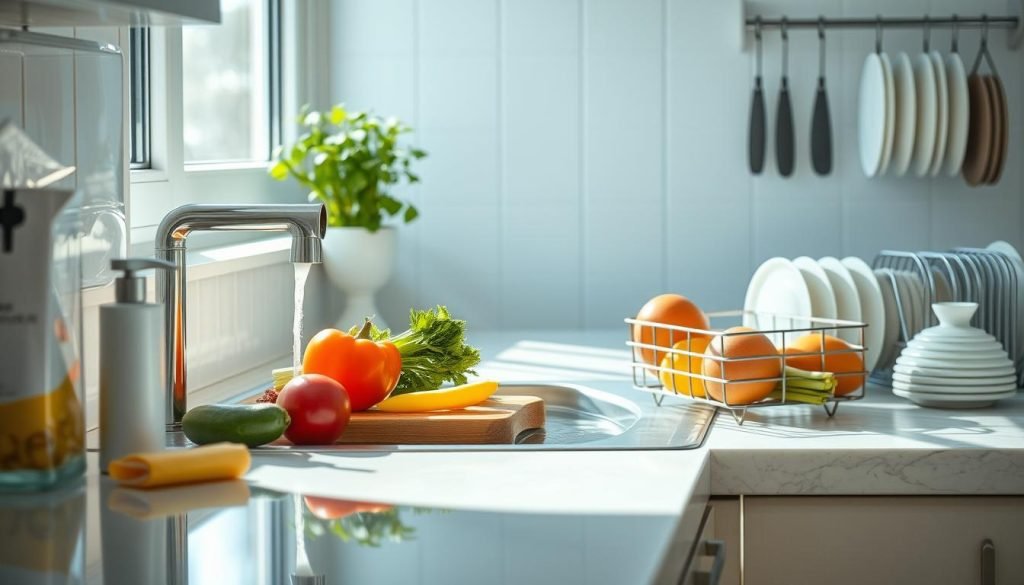
Benefits of Maintaining a Clean Kitchen
Cleaning your kitchen well is not just about stopping germs. It also lessens the chance of spreading illnesses from one food to another. Each year, 128,000 people end up in the hospital from food diseases. This often comes from using the same surfaces and tools. It’s best to clean places and items everyone touches, like door handles and utensils, every four hours in busy kitchens.
- Cost Efficiency: Avoiding foodborne illness can save businesses a lot of money, from $75,000 to $1 million for each problem.
- Health Benefits: A clean kitchen means harmful bugs can’t survive well, which is good for everyone at home.
- Food Safety: Cleaning and sanitizing right follows the FDA’s four steps for food safety—clean, separate, cook, and chill. This helps prevent getting sick.
In the end, keeping your kitchen clean is crucial for keeping food safe and everyone healthy. Regular and thorough cleaning, storing food the right way, and personal cleanliness are key to a safe kitchen.
Best Practices for Hand Hygiene
Keeping hands clean is key to food safety and stopping germs. Food workers are important in making meals safe. It’s vital they wash hands right to avoid making people sick. Let’s explore important ways to keep clean in the kitchen.
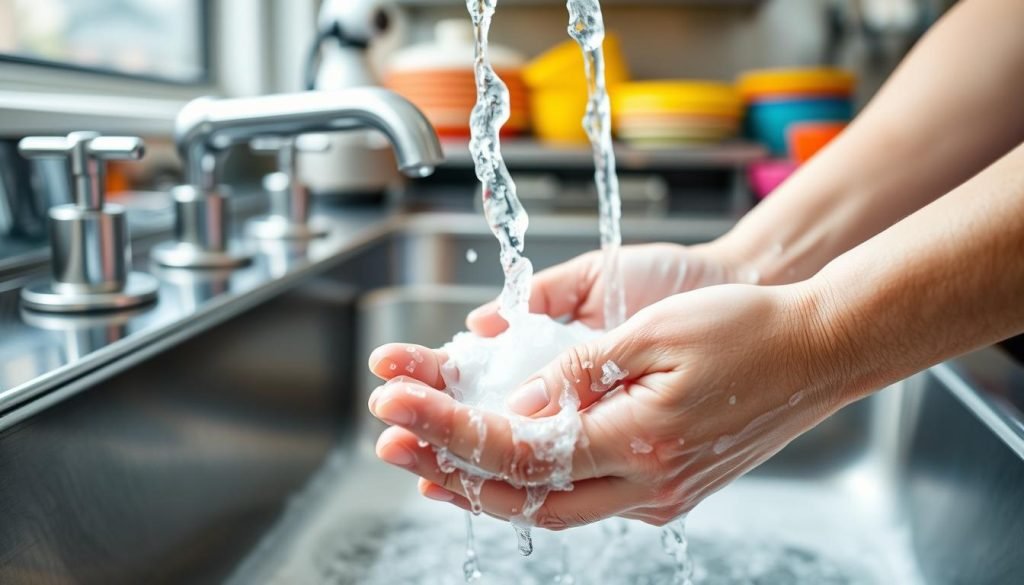
Proper Handwashing Techniques
It’s important to wash hands the right way to stop germs. Here’s how to wash your hands well:
- Wet your hands with clean, running water (warm or cold), turn off the tap, and apply soap.
- Lather your hands by rubbing them together with the soap. Make sure to lather the backs of your hands, between your fingers, and under your nails.
- Scrub your hands for at least 20 seconds. Need a timer? Hum the “Happy Birthday” song twice from beginning to end.
- Rinse your hands well under clean, running water.
- Dry your hands using a clean towel or air dry them.
When to Wash Your Hands
Knowing when to wash hands is very important. Here are the times food workers must wash:
- Before starting food preparation
- After handling raw meat, poultry, seafood, or eggs
- After touching the face, hair, or body
- After using the restroom
- After handling dirty equipment or utensils
- Before putting on food prep gloves
- After any activity that could contaminate hands
It’s shocking, but food workers wash their hands right only 33% of the time. Having sinks easy to use, managers who focus on handwashing, and visible hand sinks help. Also, restaurants with food safety training see better hand washing by their team. Let’s see what affects following hand washing rules:
| Factor | Influence on Handwashing Compliance |
|---|---|
| Accessibility of Sinks | Sinks that are easy to get to and see lead to more folks washing hands. |
| Business Volume | Being really busy might make workers wash hands less, as they hurry. |
| Management Emphasis | When managers talk a lot about hygiene, workers wash hands more. |
| Age and Role | Older workers and managers wash hands more than younger employees. |
| Training | Workers at places with food safety training wash hands as needed more. |
Safe Food Storage Techniques
Keeping food safe in the kitchen is important. Using FIFO, controlling temperatures, and labeling food properly cuts down illness risks.
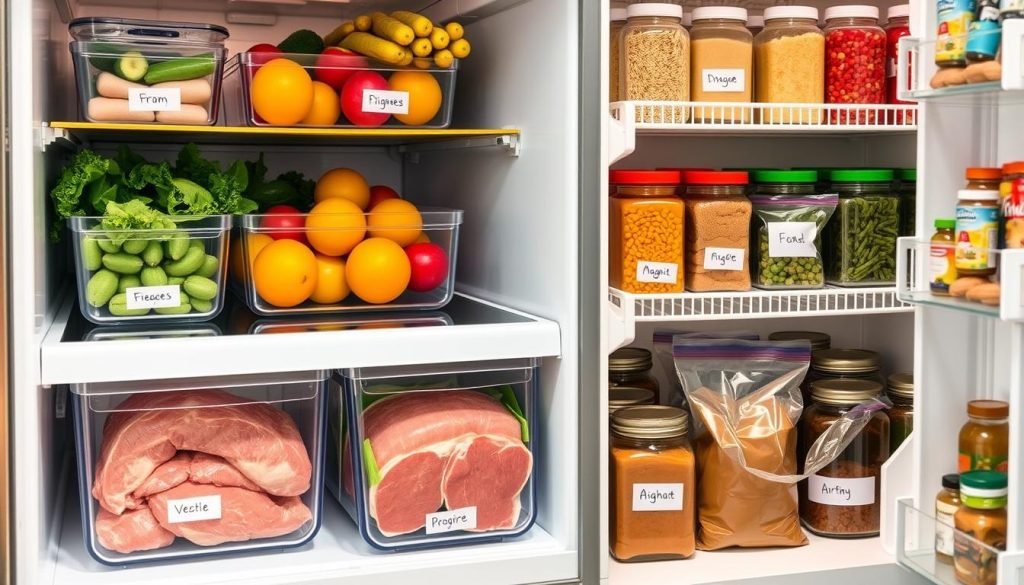
Understanding FIFO in Food Storage
The FIFO method helps keep food fresh. Put new items behind old ones to use older food first. This reduces waste and keeps food safe.
The Importance of Temperature Control
Keeping food at the right temperature is key. Keep refrigerated items below 40° F and freezers at 0° F. This stops bacteria from growing.
Check temperatures with a thermometer weekly. Don’t leave perishable foods out for too long. Follow these rules especially when it’s hot.
Proper Labeling of Food Items
Labeling food is very important. Mark the purchase and expiration dates. This helps you eat food while it’s still good.
Apps like FoodKeeper can also help. They remind you to eat food before it spoils. Using these tips makes your kitchen safer and cuts down on waste.
Cleaning and Sanitizing Surfaces
Keeping your kitchen clean and sanitized is key to a healthy space. A good cleaning routine stops harmful germs from spreading. This keeps your food safe to eat.

Difference Between Cleaning and Sanitizing
Cleaning takes away dirt and leftover food from surfaces. Sanitizing cuts down germ numbers to be safe. Both are needed for a full clean, making sure every spot is germ-free.
Recommended Cleaning Products
Choosing the right cleaners is important for killing germs. Bleach works well for sanitizing but use it safely. Quats are good too because they kill lots of germs. Always pick products that are safe for food areas, according to the FDA.
Frequency of Cleaning Tasks
Setting a cleaning schedule is a must:
- Dishes and utensils should be cleaned after use, with hot water at 171°F for sanitizing.
- Clean and sanitize places where food touches after using raw meat, changing tasks, or every four hours.
- Wipe down dining tables after each customer to keep eating areas clean.
- Wash cooking gear every day to stop gunk from building up.
Teach your workers often about these cleaning steps. Learning helps stop germs and ensures cleaners are used right.
| Task | Frequency | Details |
|---|---|---|
| Dishes and Utensils | After each use | Minimum temperature: 171°F |
| Food Contact Surfaces | Regularly during shifts | After working with raw meat, switching tasks, every four hours of use |
| Dining Tables | After each customer | Critical for maintaining hygiene in dining areas |
| Cooking Equipment | Daily | Prevent residue buildup and health hazards |
Preventing Cross-Contamination
Cross-contamination can make people sick. It happens when germs move from raw to cooked food. Keeping the kitchen clean stops this from happening. Different food handling steps are key.

Understanding Cross-Contamination
Germs move when we don’t want them to. This can be from hands, tools, or places where we prepare food. At a university, 32 people got sick because of this. Someone used the wrong cutting board and caused a big problem.
Tips to Avoid Cross-Contamination
Here are ways to keep the kitchen safe:
- Separate raw foods: Use separate places and tools for raw meat, fish, and others. And different ones for fruits, veggies, and ready foods.
- Proper labeling: Have special containers for raw and ready foods with clear labels. Raw ones should close tightly to stop leaks.
- Regular handwashing: Always wash your hands well after you touch raw meat, fish, and poultry.
- Clean as you go: Keep tools, surfaces, and plastic things clean with hot soapy water to kill germs.
- Temperature control: Keep cut fruits and veggies cold, at or below 41°F, to stop germs from growing.
- Proper food storage: Keep food and other items off the floor by at least 6 inches to avoid dirt and germs.
- Separate reusable bags: Don’t use the same bags for carrying both raw and ready-to-eat foods.
- Dedicated prep times: Get ready raw meat, seafood, and poultry at different times than when you prepare ready-to-eat foods.
- Sanitize workstations: Always clean and make germ-free cutting boards and tools when switching between different foods.
- Safe chemical storage: Keep cleaning stuff and chemicals away from where food is kept to avoid mix-ups.
| Key Practice | Details |
|---|---|
| Separate raw foods | Use different cutting boards and utensils for raw meat and other foods |
| Proper labeling | Containers for raw foods should have sealed lids |
| Temperature control | Refrigerate items like sliced melons at or below 41°F |
| Handwashing | Wash hands after handling raw meat, fish, and poultry |
| Store food properly | Items should be 6 inches off the floor |
Food Preparation Safety Tips
It’s super important to make sure we prepare food safely. The CDC tells us that each year, 1 in 6 people get sick from the food they eat. This results in about 128,000 people going to the hospital and 3,000 deaths.
Safe Thawing Methods
Knowing the right way to thaw food is key for keeping it safe. Don’t thaw food on the counter since it can grow bacteria. Here are safe ways to do it:
- Refrigerator Thawing: Thaw food in the fridge to keep it cool and safe.
- Cold Water Thawing: Put the food in cold water. Change the water every 30 mins.
- Microwave Thawing: Defrost the food in your microwave. Then, cook it right away.

Cooking Foods to Safe Temperatures
While cooking, it’s vital to hit the right temperatures to kill germs. Here’s what temperatures to reach:
| Food Type | Internal Temperature (°F) |
|---|---|
| Beef, Pork, Lamb | 145°F |
| Fish | 145°F |
| Ground Beef, Pork, Lamb | 160°F |
| Turkey, Chicken, Duck | 165°F |
Sticking to these temperatures helps prevent food sickness. Don’t forget the 2-Hour Rule either. Put leftovers in the fridge within 2 hours. If it’s hot outside (above 90°F), do it within 1 hour. Following these steps is super important for keeping food safe.
Proper Kitchen Waste Management
Keeping your kitchen clean and green is key. Making sure food waste is tossed right and trash goes out often makes a big difference. Both your home and the planet will thank you.
Safe Disposal of Food Waste
Getting rid of food waste the right way is super important for a clean kitchen. Learning the best ways to do this can keep bugs away and make everything nice and neat. Having special bins for things that can turn into compost helps a lot.
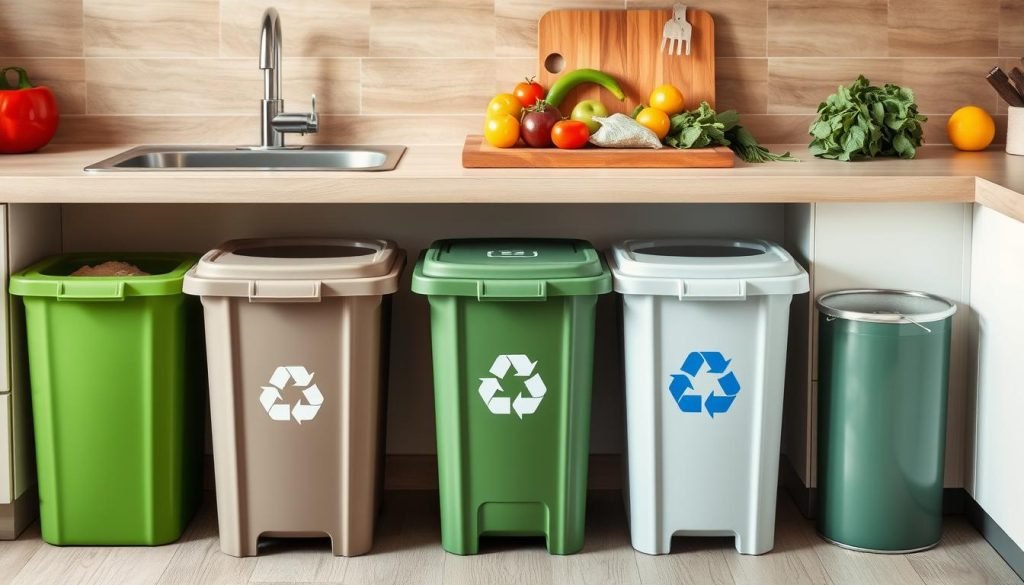
Importance of Regular Trash Removal
Keeping trash from piling up stops bad smells and keeps your kitchen clean. If you throw out garbage often, your kitchen stays safe for making meals. It’s really important for stopping sickness from spreading.
Doing these things keeps your kitchen spotless and is good for our planet too. Here are some tips to follow:
- Sort your trash to make getting rid of it easier.
- Try to turn food scraps into compost to lessen trash.
- Clean your trash cans often so they don’t get yucky.
Check out this table for why managing kitchen waste matters:
| Benefit | Description |
|---|---|
| Reduces Foodborne Illnesses | Throwing away trash right cuts down on germs and sickness. |
| Minimizes Odors | Taking trash out often stops bad smells in the kitchen. |
| Helps Environmental Sustainability | Good waste habits mean less trash in landfills and cleaner air. |
| Improves Kitchen Hygiene | A clean kitchen stops bugs and makes a healthier place to cook. |
Handling Leftovers Safely
Leftovers make meal planning easier but need careful handling to stay safe. To avoid getting sick, know how to store them and when to throw them away.
Storing Leftovers Properly
Leftovers should be in the fridge or freezer within two hours of cooking. If it’s very hot out, like over 90°F, do this in one hour. This includes time before serving and during your meal.
Use shallow containers for quick cooling of cooked food. Deep containers keep the middle too warm, which can make bacteria grow. Reheat leftovers to 165°F all through. For sauces and soups, boil them. Stir food in the microwave to avoid cold spots.
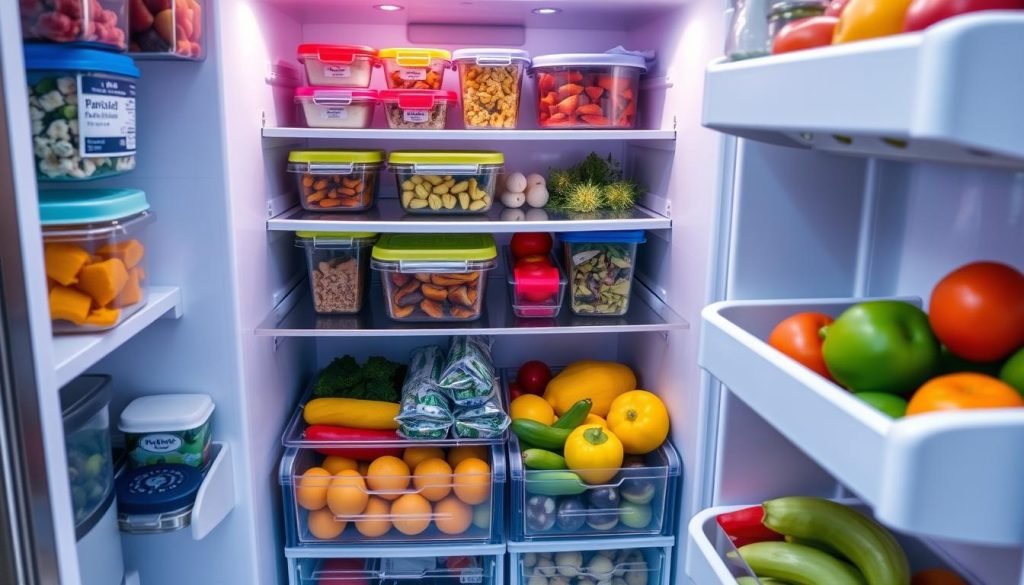
When to Discard Leftovers
It’s important to know when to throw leftovers away to stay safe. You should eat or freeze them within four days. Throw them out if they look or smell odd.
Hot food must stay above 140°F, and cold food below 40°F to be safe. Bacteria can grow fast between 40°F and 140°F. Keep food outside this danger zone.
If perishable food is out too long, over two hours, or one hour if it’s hot, throw it away. Leftovers last 3 to 4 days in the fridge or up to 4 months in the freezer. Always reheat to 165°F for safety.
Educating Family Members on Food Safety
Keeping the family safe from foodborne illness is key. By teaching them food safety, we keep our kitchens clean. This helps protect everyone we love from getting sick.
Importance of Food Safety Education
Each year, 48 million people get sick from food. This leads to 128,000 in the hospital and 3,000 deaths. Teaching our families about safe food handling can cut these numbers down. It’s really important for kids, older people, and anyone who gets sick easily.
- Understanding food safety: Tell your family about the “Danger Zone” (40°F – 140°F), where bad germs grow fast.
- Following guidelines: Remind them about the 2-Hour Rule. It says not to leave food out longer than two hours.
- Using thermometers: Talk about the need for food thermometers. Right now, only 23% use them for cooking burgers.
Engaging Kids in Kitchen Hygiene
Talking to kids about keeping the kitchen clean is fun and good for them. They learn how to stay safe around food. This teaches them habits they’ll use forever.
- Let them help by washing fruits and veggies.
- Show them how and when to wash their hands, like before and after touching food.
- Use pictures and games to teach them about germs and being clean.
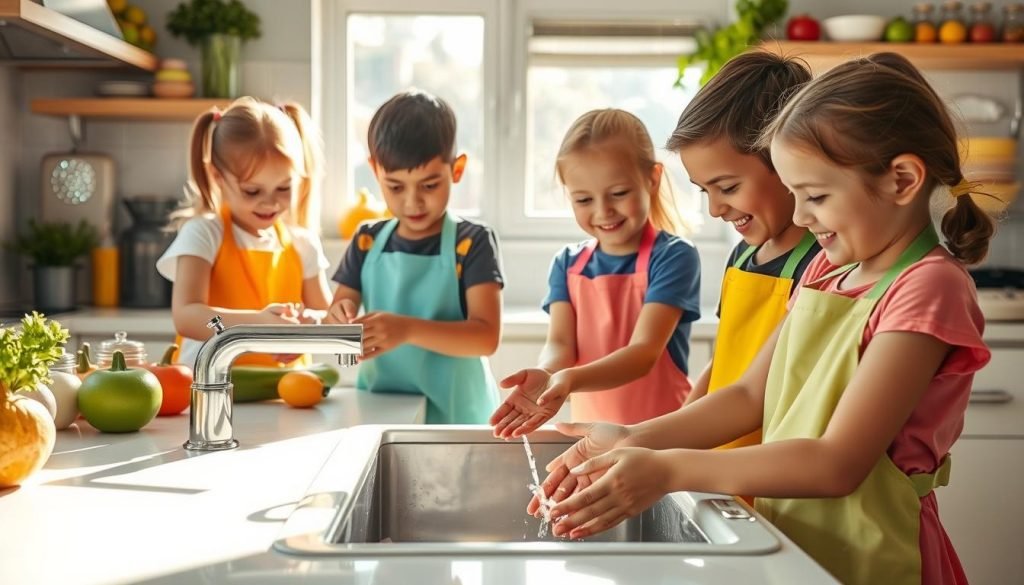
Food safety is a family task. It makes our kitchens safer and teaches everyone important lessons. The FDA says to always Wash, Separate, Cook, and Chill food. These are easy to learn and do at home.
Add these steps to every day to keep your kitchen safe for all:
| Food Type | Storage Time (Refrigerator) |
|---|---|
| Bacon (opened) | 5-7 days |
| Raw beef roasts & steaks | 3-5 days |
| Fresh eggs in shell | 3-5 weeks |
| Raw poultry | 1-2 days |
| Opened hotdogs | 3-7 days |
| Fresh milk | 5-7 days |
We all should learn and teach our families about kitchen cleanliness. Start now by making kids part of it. Making food safety a big deal at home can stop illness from bad food.
How Do Must-Have Kitchen Utensils Contribute to Kitchen Hygiene and Safety?
Keeping a clean kitchen is vital for food safety, and using essential cooking tools plays a significant role. Proper utensils reduce the risk of cross-contamination and ensure food is prepared hygienically. Investing in high-quality, dedicated essential cooking tools helps maintain a safe and healthy cooking environment for everyone.
Conclusion: Maintaining a Safe Kitchen Environment
Keeping your kitchen safe is a never-ending process. By using food safety methods, you help stop sicknesses from food. Teaching everyone in the house, especially kids, about cleanliness is key.
Summary of Key Points
It’s important to wash your hands for 20 seconds before and after you touch food. This stops germs from spreading. Always clean places like countertops and boards with hot soapy water. This keeps germs away.
Store food safely to keep it good for longer. Use the fridge the right way and label your food. Use different boards for different foods. And wash your hands a lot to keep your kitchen safe.
Encouragement for Ongoing Safe Practices
Your hard work in keeping the kitchen clean protects your family from getting sick. Simple things matter, like washing fruits and throwing away trash right. Teach your family about staying clean too.
Let’s keep making our kitchens safer. If we all do our part, we can stop sicknesses from spreading. And make our homes healthier for everyone.